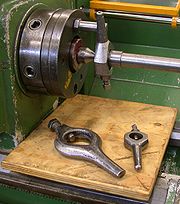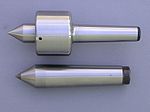
Lathe center
Encyclopedia

The primary use of a center is to ensure concentric
Concentric
Concentric objects share the same center, axis or origin with one inside the other. Circles, tubes, cylindrical shafts, disks, and spheres may be concentric to one another...
work is produced, this allows the workpiece to be transferred between operations without any loss of accuracy. A part may be turned in a lathe
Lathe
A lathe is a machine tool which rotates the workpiece on its axis to perform various operations such as cutting, sanding, knurling, drilling, or deformation with tools that are applied to the workpiece to create an object which has symmetry about an axis of rotation.Lathes are used in woodturning,...
, sent off for hardening
Hardening (metallurgy)
Hardening is a metallurgical and metalworking process used to increase the hardness of a metal. The hardness of a metal is directly proportional to the uniaxial yield stress at the location of the imposed strain...
and tempering and then ground between centers in a cylindrical grinder
Cylindrical grinder
The cylindrical grinder is a type of grinding machine used to shape the outside of an object. The cylindrical grinder can work on a variety of shapes, however the object must have a central axis of rotation...
. The preservation of concentricity between the turning and grinding operations is crucial for quality work.
A center is also used to support longer workpieces where the cutting
Tool bit
The term tool bit generally refers to a non-rotary cutting tool used in metal lathes, shapers, and planers. Such cutters are also often referred to by the set-phrase name of single-point cutting tool. The cutting edge is ground to suit a particular machining operation and may be resharpened or...
forces would deflect the work excessively, reducing the finish and accuracy of the workpiece, or creating a hazardous situation.
A center has applications anywhere that a centered workpiece may be used, this is not limited to lathe usage but may include setups in dividing head
Indexing head
An indexing head, also known as a dividing head or spiral head, is a specialized tool that allows a workpiece to be circularly indexed; that is, easily and precisely rotated to preset angles or circular divisions...
s, cylindrical grinders, tool and cutter grinder
Tool and Cutter grinder
A tool and cutter grinder is used to sharpen milling cutters and tool bits along with a host of other cutting tools.It is an extremely versatile machine used to perform a variety of grinding operations: surface, cylindrical, or complex shapes...
s or other related equipment. The term between centers refers to any machining operation where the job needs to be performed using centers.
A center is inserted into a matching hole drilled by a center drill.
Dead center

Friction welding
Friction welding is a class of solid-state welding processes that generates heat through mechanical friction between a moving workpiece and a stationary component, with the addition of a lateral force called "upset" to plastically displace and fuse the materials...
from occurring. Additionally the tip of the center may have an insert of carbide
Tungsten carbide
Tungsten carbide is an inorganic chemical compound containing equal parts of tungsten and carbon atoms. Colloquially, tungsten carbide is often simply called carbide. In its most basic form, it is a fine gray powder, but it can be pressed and formed into shapes for use in industrial machinery,...
which will reduce the friction slightly and allow for faster speeds. Dead centers may also be fully hardened to prevent damage to the important mating surfaces taper of the taper and to preserve the 60° nose taper.
Soft center
Soft centers are identical to dead centers except the nose is deliberately left soft (unhardened) so that it may be readily machined to the correct angle prior to usage. This operation is performed on the headstock center to ensure that the centers axis is aligned with the spindles axis.Live or revolving center
A live center or revolving center is constructed so that the 60° center runs in its own bearings and is used at the non-driven or tailstock end of a machine. It allows higher turning speeds without the need for separate lubrication, and also greater clamping pressures. CNC lathes use this type of center almost exclusively and they may be used for general machining operations as well. Spring-loaded live centers are designed to compensate for center variations, without damage to the work piece or center tip. This assures the operator of uniform constant tension while machining. Some live centers also have interchangeable shafts. This is valuable when situations require a design other than a 60° male tip.Pipe center
A pipe center has a larger diameter at the 60° taper end. This allows the center to be used in the bore of a pipe (or similar workpiece). While a pipe center ensures the workpiece remains concentric, its main advatage is that it supports the workpiece securely. Thin walled material such as pipes easily collapse if excessive pressures are used at the chuck end,Cup center
The cup center is a variation of the live center and is used in woodworking to support the softer material around the actual center and prevent the material splitting.Drive center
A drive center is used in the driving end of the machine (headstock). It consists of a dead center surrounded by hardened teeth. These teeth bite into the softer workpiece allowing the workpiece to be driven directly by the center. This allows the full diameter of the workpiece to be machined in a single operation, this contrasts with the usual requirement where a carrierLathe carrier
A lathe dog, also known as a lathe carrier, is a device that clamps around the workpiece and allows the rotary motion of the machine's spindle to be transmitted to the workpiece....
is attached to the workpiece at the driven end. They are often used in woodworking or where softer materials are machined.
Drive Centre is also known as Grip centre in some industrial circles. Another modification made to the Drive centre is that Shell End Mills are modified and used instead of hardened pins that enable better gripping and also that used of used Shell end mills after Grinding the edges. This prevents breakdown time due to pin stop

